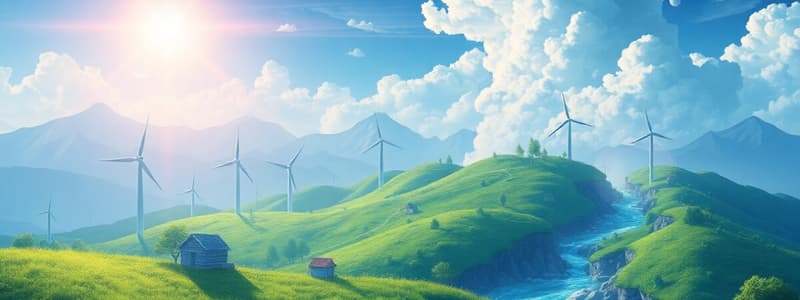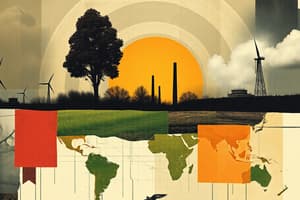Podcast
Questions and Answers
Which of these options is an example of potential energy?
Which of these options is an example of potential energy?
- The wind blowing through the trees
- A stretched rubber band (correct)
- A flowing river
- A moving car
What is the primary reason for the increase in global energy consumption since the Industrial Revolution?
What is the primary reason for the increase in global energy consumption since the Industrial Revolution?
- Technological advancements in energy efficiency
- Decreased population growth
- Improved access to energy in developing nations
- Increased use of renewable energy sources
- Population growth and economic development (correct)
What is the primary greenhouse gas released by fossil fuel combustion?
What is the primary greenhouse gas released by fossil fuel combustion?
- Carbon dioxide (CO2) (correct)
- Sulfur dioxide (SO2)
- Nitrogen dioxide (NO2)
- Methane (CH4)
Which of the following is NOT a renewable energy source?
Which of the following is NOT a renewable energy source?
What does the term 'peak oil' refer to?
What does the term 'peak oil' refer to?
Which of these is a major concern associated with hydraulic fracturing (fracking)?
Which of these is a major concern associated with hydraulic fracturing (fracking)?
What is the primary difference between photovoltaic (PV) cells and solar thermal collectors?
What is the primary difference between photovoltaic (PV) cells and solar thermal collectors?
What is the primary benefit of nuclear energy compared to fossil fuels?
What is the primary benefit of nuclear energy compared to fossil fuels?
Which of these is a major concern associated with nuclear power?
Which of these is a major concern associated with nuclear power?
What is the rebound effect in energy efficiency?
What is the rebound effect in energy efficiency?
What is the primary goal of the Paris Agreement?
What is the primary goal of the Paris Agreement?
Which of the following is NOT a benefit of energy efficiency improvements?
Which of the following is NOT a benefit of energy efficiency improvements?
Which of these is a potential concern associated with wind energy?
Which of these is a potential concern associated with wind energy?
Which of the following is an example of energy conservation?
Which of the following is an example of energy conservation?
What is the primary challenge facing nuclear fusion as a potential energy source?
What is the primary challenge facing nuclear fusion as a potential energy source?
Which of these describes the concept of energy equity?
Which of these describes the concept of energy equity?
Flashcards
Energy
Energy
The capacity to do work or cause change.
Kinetic Energy
Kinetic Energy
Energy of motion, such as wind or flowing water.
Potential Energy
Potential Energy
Stored energy due to position or condition, like chemical bonds.
Law of Conservation of Energy
Law of Conservation of Energy
Signup and view all the flashcards
Power
Power
Signup and view all the flashcards
Efficiency
Efficiency
Signup and view all the flashcards
Renewable Energy
Renewable Energy
Signup and view all the flashcards
Fossil Fuels
Fossil Fuels
Signup and view all the flashcards
Solar Energy
Solar Energy
Signup and view all the flashcards
Nuclear Energy
Nuclear Energy
Signup and view all the flashcards
Energy Efficiency Improvements
Energy Efficiency Improvements
Signup and view all the flashcards
Carbon Pricing
Carbon Pricing
Signup and view all the flashcards
Energy Storage Technologies
Energy Storage Technologies
Signup and view all the flashcards
Energy Equity
Energy Equity
Signup and view all the flashcards
Paris Agreement
Paris Agreement
Signup and view all the flashcards
Study Notes
Energy Basics
- Energy is the capacity to do work or cause change.
- Kinetic energy is the energy of motion.
- Potential energy is stored energy due to position or configuration.
- The Law of Conservation of Energy states energy cannot be created or destroyed, only converted.
- Energy transformations change energy from one form to another.
- Power is the rate of energy transfer or conversion, measured in watts (W) or joules per second (J/s).
- Efficiency is the ratio of useful energy output to total energy input, expressed as a percentage. High efficiency minimizes waste.
Types of Energy Resources
- Renewable resources replenish naturally (solar, wind, hydropower).
- Renewable sources are sustainable and have lower environmental impact compared to non-renewable sources.
- Non-renewable resources are finite and depleted faster than replenished (fossil fuels, nuclear).
- Fossil fuels are organic matter converted into coal, oil or natural gas over millions of years.
- Nuclear energy is released via nuclear fission or fusion reactions.
- Alternative energy sources include geothermal, tidal, and biomass.
Fossil Fuels
- Coal is formed from ancient plant remains, burned to generate electricity but produces pollutants.
- Oil (petroleum) is a liquid fossil fuel formed from marine organisms.
- Natural gas is primarily composed of methane and is formed alongside oil deposits. It is cleaner burning than coal or oil but still emits greenhouse gases.
- Hydraulic fracturing (fracking) releases trapped oil and gas but is controversial due to potential environmental impacts.
- Fossil fuel combustion releases carbon dioxide (CO2), a greenhouse gas contributing to climate change.
- Peak oil is the point where global oil production reaches its maximum rate, raising energy security concerns.
Renewable Energy Sources
- Solar energy converts sunlight to electricity using PV cells or concentrated solar thermal systems.
- Wind energy uses wind turbines to convert kinetic energy to electricity. Offshore wind farms are more consistent.
- Hydropower uses water flow through turbines in dams or run-of-river systems to generate energy, but can disrupt ecosystems.
- Geothermal energy uses heat from the Earth's crust for heating, cooling, and electricity generation.
- Biomass uses organic matter (wood, crops, waste) as fuel. It may be carbon-neutral if regrowth absorbs the released CO2 but may displace food or habitat production.
- Tidal energy uses the tides' rise and fall to generate electricity, but is limited to areas with high tidal ranges.
Nuclear Energy
- Nuclear fission splits heavy atomic nuclei (e.g., uranium-235) to release energy.
- Nuclear power plants use controlled fission to generate steam for turbines.
- Nuclear fusion combines light atomic nuclei (e.g., hydrogen) forming heavier elements which releases energy. Fusion is difficult to control.
- Nuclear power has high energy density, low greenhouse gas emissions, and reliable baseload generation but also faces high construction costs, risks of accidents and long-term radioactive waste disposal problems.
- Uranium enrichment increases the concentration of fissile uranium-235 for nuclear fuel, leading to proliferation concerns.
- Nuclear fusion research aims for a clean, limitless energy source but faces challenges maintaining stable plasma confinement and achieving net energy gain.
Energy Consumption Patterns
- Global energy consumption has greatly increased since the Industrial Revolution.
- Fossil fuels currently dominate the global energy mix.
- Developed countries have higher per capita energy consumption than developing countries.
- Energy poverty affects over 1 billion people, limiting economic opportunities in developing regions.
Environmental Impacts
- Fossil fuel combustion releases greenhouse gases (GHGs) contributing to climate change (rising sea levels, extreme weather events).
- Air pollution harms human health, causes acid rain, and reduces visibility.
- Oil spills devastate marine environments.
- Mining and drilling can degrade land and disrupt ecosystems.
- Nuclear accidents release radioactive material, causing long-term environmental harm.
Future of Energy
- Transitioning to a low-carbon energy system is crucial for mitigating climate change.
- Renewable energy, energy efficiency, electrification are needed.
- Energy storage technologies (batteries, pumped hydro, hydrogen) are essential for integrating variable renewables.
- Smart grids optimize energy distribution.
- Carbon pricing mechanisms (carbon taxes, cap-and-trade) incentivize cleaner energy adoption.
- International cooperation is needed to address global energy and climate challenges.
- Energy equity ensures access to affordable, reliable, and clean energy for all.
Studying That Suits You
Use AI to generate personalized quizzes and flashcards to suit your learning preferences.




